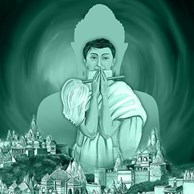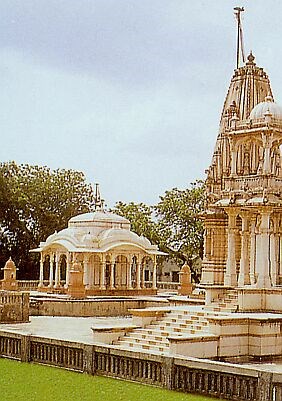- 20-07-2025
- 03-08-2025
- 17-08-2025

Diwali has a very special significance in Jainism, just like Buddha Purnima, the date of Buddha's Nirvana, is for Buddhists and Christmas is for Christians. Lord Mahavira, the last of the Jain Tirthankaras, attained Nirvana or Moksha on this day at Pavapuri on Oct. 15, 527 BCE, on Chaturdashi of Kartika:
कत्तिय-किण्हे चौदसिपच्चुसे सादिणामनक्खत्ते|
पवाए णयरिये एक्को विरेसरो सिद्धो ||
Lord Mahavira is responsible for establishing the Dharma followed by Jains even today. According to tradition, the chief disciple of Mahavira, Ganadhar Gautam Swami also attained complete knowledge (Kevalgyana) on this day, thus making Divali one of the most important Jain festivals.
Lord Mahavira attained his nirvana at the dawn of the amavasya (new moon). According to the Kalpasutra by Acharya Bhadrabahu, 3rd century BC, many gods were present, illuminating the darkness[5]. The following night was pitch black without the light of the gods or the moon. To symbolically keep the light of their master's knowledge alive.
Replica of Pava temple at Pansara. Mahavira attained Nirvana at Pava.


16 gana-kings, 9 Malla and 9 Lichchhavi, of Kasi and Kosal, illuminated their doors. They said: "Since the light of knowledge is gone, we will make light of ordinary matter" ("गये से भवुज्जोये, दव्वुज्जोयं करिस्समो").
The word "Divali" is a corruption of the Sanskrit word "Deepavali" (also transliterated as "Dipavali"). Deepa/dipa means "light of the dharma", and avali means "a continuous line". The more literal translation is "rows of clay lamps".
Deepavali was first mentioned in Jain books as the date of the nirvana of Lord Mahavira. In fact, the oldest reference to Divali is a related word, dipalikaya or deepalikaya, which occurs in Harivamsha-Purana, written by Acharya Jinasena [6]and composed in the Shaka Samvat era in the year 705.
ततस्तुः लोकः प्रतिवर्षमादरत् प्रसिद्धदीपलिकयात्र भारते |
समुद्यतः पूजयितुं जिनेश्वरं जिनेन्द्र-निर्वाण विभूति-भक्तिभाक् |२० |
tatastuh lokah prativarsham-aadarat
prasiddha-deepalikaya-aatra bharate
samudyatah poojayitum jineshvaram
jinendra-nirvana vibhuti-bhaktibhak
Translation: The gods illuminated Pavanagari by lamps to mark the occasion. Since that time, the people of Bharat celebrate the famous festival of "Dipalika" to worship the Jinendra (i.e. Lord Mahavira) on the occasion of his nirvana.
Deepalikaya roughly translates as "light leaving the body". Dipalika, which can be roughly translated as "splenderous light of lamps", is used interchangeably with the word "Divali".
The way Jains celebrate Divali is different in many respects. There is a note of asceticism in whatever the Jains do, and the celebration of Divali is not an exception. The Jains celebrate Divali during the month of Kartik for three days. During this period, among the Shvetambaras, devoted Jains observe fasting and chant the Uttaradhyayan Sutra, which contain the final pravachans of Lord Mahavira, and meditate upon him. Some Jains visit Pavapuri in Bihar where he attained Nirvan. In may temples special laddus are offered particularly on this day.
Vira Nirvana Samvat: The Jain year starts with Pratipada following Divali. Vira Nirvana Samvat 2534 starts with Divali 2007. The Jain businesspeople traditionally started their accounting year from Divali.
On 21st October 1974 1974 the 2500th Nirvana Mahotsava was celebrated by all the Jain throughout India[7].
Reference - http://en.wikipedia.org/wiki/Diwali
Permission is granted to copy, distribute and/or modify this document under the terms of the GNU Free Documentation License, Version 1.2 or any later version published by the Free Software Foundation; with no Invariant Sections, no Front-Cover Texts, and no Back-Cover Texts. A copy of the license is included in the section entitled "GNU Free Documentation License".